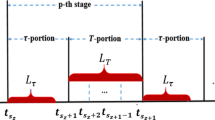Abstract
A two-stage H ∞ optimization methodology is presented for designing multirate controllers achieving comparable H ∞ closed-loop performance with that of an optimal fast rate design at a reduced real-time computational load. In the first stage, a fast rate controller is designed by solving an H ∞ optimal control problem formulated to address the design specifications; then the fast rate controller is decomposed into low frequency and high frequency parts. In the second stage, the high frequency part of the controller is retained and the low frequency part is redesigned at the slow rate using lifting and H ∞ optimization. In the proposed approach, potential problems of aliasing due to the multirate nature of the controller are addressed by taking into consideration closed-loop performance.
Similar content being viewed by others
References
R. Meyer and C. Burrus, “A unified analysis of multirate and periodically time-varying digital filters,” IEEE Trans. on Circuits and Systems, vol. 22, no. 3, pp. 162–168, March 1975.
A. S. Mehr and T. Chen, “Representations of linear periodically time-varying and multirate systems,” IEEE Trans. on Signal Processing, vol. 50, no. 9, pp. 2221–2229, September 2002.
T. Chen and L. Qiu, “Linear periodically timevarying discrete-time systems: aliasing and LTI approximations,” Syst. Control Lett., vol. 30, no. 5, pp. 225–235, 1997.
J. Ding, F. Marcassa, S.-C. Wu, and M. Tomizuka, “Multirate control for computation saving,” IEEE Trans. on Control Systems Technology, vol. 14, no. 1, pp. 165–169, January 2006.
S.-H. Lee, “Multirate digital control system design and its application to computer disk drives,” IEEE Trans. on Control Systems Technology, vol. 14, no. 1, pp. 124–133, January 2006.
Q. Jia, “New design of multirate digital control scheme for computation saving,” Proc. of IEEE Int. Conf. on Industrial Technology, pp. 1–4, April 2008.
R. Bhattacharya and G. J. Balas, “Control in Computationally Constrained Environments,” IEEE Trans. on Automatic Control, vol. 17, no. 3, pp. 589–599, May 2009.
T. Chen and B. A. Francis, Optimal Sampled-Data Control Systems, Springer-Verlag, New York, 1995.
R. G. Shenoy, “Multirate specifications via alias-component matrices,” IEEE Trans. on Circuits and Systems II: Analog and Digital Signal Processing, vol. 45, no. 3, pp. 314–320, March 1998.
B. A. Francis, A Course in H ∞ Control Theory, Springer-Verlag, New York, 1987.
S. Mirabbasi, B. A. Francis, and T. Chen, “Inputoutput gains of linear periodic discrete time systems with application to multirate signal processing,” Proc. of ISCAS, 1995.
Y. Li, F. Marcassa, R. Horowitz, R. Oboe, and R. Evans, “Track-following control with active vibration damping of a PZT-actuated suspension dual-stage servo system,” Proc. of the American Control Conference, vol. 3, pp. 2553–2559, June 2003.
Y. Li and R. Horowitz, “Design and testing of track-following controllers for dual-stage servo systems with PZT actuated suspensions,” Micro System Technologie, vol. 8, pp. 194–205, June 2002.
Author information
Authors and Affiliations
Corresponding author
Additional information
Recommended by Editorial Board member Pinhas Ben-Tzvi under the direction of Editor Hyungbo Shim.
We gratefully acknowledge support from the Balsells Foundation and the Western Digital Corporation.
Sergio López-López received his B.S. in Electrical Engineering from the Technical University of Catalonia, Spain, in 2003 and his M.S. and Ph.D. degrees in Mechanical Engineering in 2007 and 2010, respectively from University of California, Irvine. He is currently with ABB Switzerland, as a Control Engineer in traction applications. His research interests include robust control, multirate control, and H ∞ optimal control.
Athanasios Sideris received his Diploma in Electrical and Mechanical Engineering from the National Technical University of Athens, Greece, in 1980, and his M.S. and Ph.D. degrees in Electrical Engineering in 1981 and 1985, respectively, from the University of Southern California, Los Angeles, CA. Since 1992, he has been with the Department of Mechanical and Aerospace Engineering at the University of California, Irvine where he is currently Professor. His research interests include robust and optimal control, optimization, and machine learning. Dr. Sideris is an Associate Editor for the International Journal of Robust and Nonlinear Control.
Jie Yu received his B.S. degree in Electrical Engineering in 1989 and an M.S. degree in Chemical Engineering in 1992, from Zhejiang University, Hangzhou, China, and a Ph.D. degree in Mechanical and Aerospace Engineering in 1997 from the University of California, Irvine. Currently Dr. Yu is Sr. Director Engineering with Western Digital Technologies, Irvine. His research interests lie in the area of robust control, digital control, and their industrial applications.
Rights and permissions
About this article
Cite this article
López-López, S., Sideris, A. & Yu, J. Two-stage H ∞ optimization approach to multirate controller design. Int. J. Control Autom. Syst. 10, 675–683 (2012). https://doi.org/10.1007/s12555-012-0402-9
Received:
Revised:
Accepted:
Published:
Issue Date:
DOI: https://doi.org/10.1007/s12555-012-0402-9



